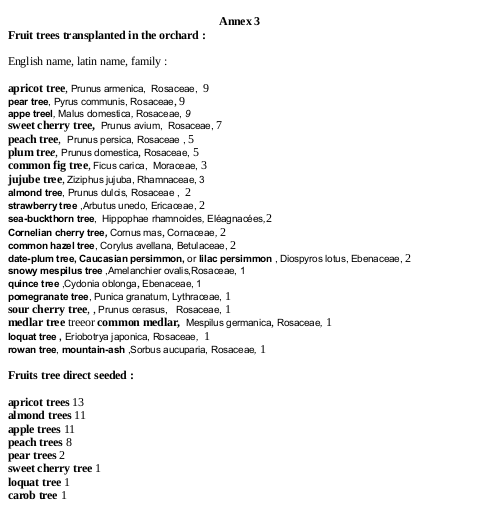France: Shared orchard in Castries in July 2019
A shared “eco-orchard” of 8400 m2 has been implanted in Castries near Montpellier (mediterranean climate) with local, rustic fruit trees, using the direct seeding technique, in order to eventually have a “forest orchard” producing its own forest soil, without irrigation or other inputs.
Keywords : Mediterranean rain fed orchard, fruit trees direct seeding, eco-orchard.
Introduction
A plot of land of 8400 m2 belonging to the municipality of Castries was lent at the end of 2016 to
the association “Verger partagé de Castries”, which has about 60 registered members.
The objective is to test a rain fed orchard, as diversified as possible whith local fruit tree species,
rustic, without inputs or irrigation, eventually becoming an agroforest including wild edges and various trees pruned to enrich the soil that would become forest soil.
Climate
The climate of Montpellier is typically mediterranean. The result is fairly mild temperatures
(15.2°C on average), one of the highest levels of sunshine in France with only 33 days without
sunshine per year, lasting an average of 7h22 min per day, well above the French average of 4h46
min; and few rainy days (less than 60 per year), but sometimes heavy showers. (Annex 1)
Agronomic aspect
- Deep clay-limestone soil, floodable by heavy rain, presence of limestone concretions about 50 cm. The soil is extremely compact when dry and vulnerable to compaction when wet.
- Previous cultivation, mowed and exported natural grasslands, no input. Twenty years ago, the plot had been a wineyars which was frequently treated with Bordeaux mixture (a fungizide: CuSO4 with Ca(OH)2) and other pesticides. The soil is therefore probably rich in copper.
- Weeds are not removed, only the paths between the trees are mowed (Annex 2).
Planting methods
The first planting from December 2016 to January 2017 was obtained with nursery grafted plants, spaced with 10 m distance. It includes 69 fruit trees (Annex 3).
The planting was done during collective workcamps. The recommendation was to plant on dams because of the low filtering capacity of the soil. This was, however, not always respected, causing some losses of plants due to lack of oxygen of the young roots.
The trees received one to two wheelbarrows of woody green wastes (BRF) for mulching.
The second planting was done by direct seeding of 50 trees (Annex 3), in November/December 2017, with collected seeds or pits and from January to March 2018 with sprouted seeds or pits. The idea is that trees from direct seeding develop a taproot that penetrates deep into the soil, giving them a superiority over transplanted trees. It is also an opportunity to observe genetic variability and perhaps find more hardy varieties that adapt to climate change. Since the orchard does not have an economic objective, we can monitor the results and graft when the result is not satisfactory in terms of both fruit quality or productivity.
Maintenance
In the first two years, the transplanted grafted trees received two irrigations during the summer, with a garden hose, about 200 litres per tree to encourage deep rooting.
Mulching is maintained by adding 2 to 3 wheelbarrows woody green waste provided by the municipality during the winter.
The transplanted trees are only slightly pruned. Direct seeded trees are thinned out to get only one tree per placement. They are not irrigated and not pruned.
Weeds are not cut, with the exception of the visit groves. Wild trees: acacias, ash trees, poplars, elms etc. which grow spontaneously are pruned to 1m to complete the mulching.
This orchard requires little work. The transplanted trees that die are replaced by direct seeding. Beans were planted around the direct seedlings, which produced well in the first year, but nothing in the second year because there was no rain during winter nor during spring.







